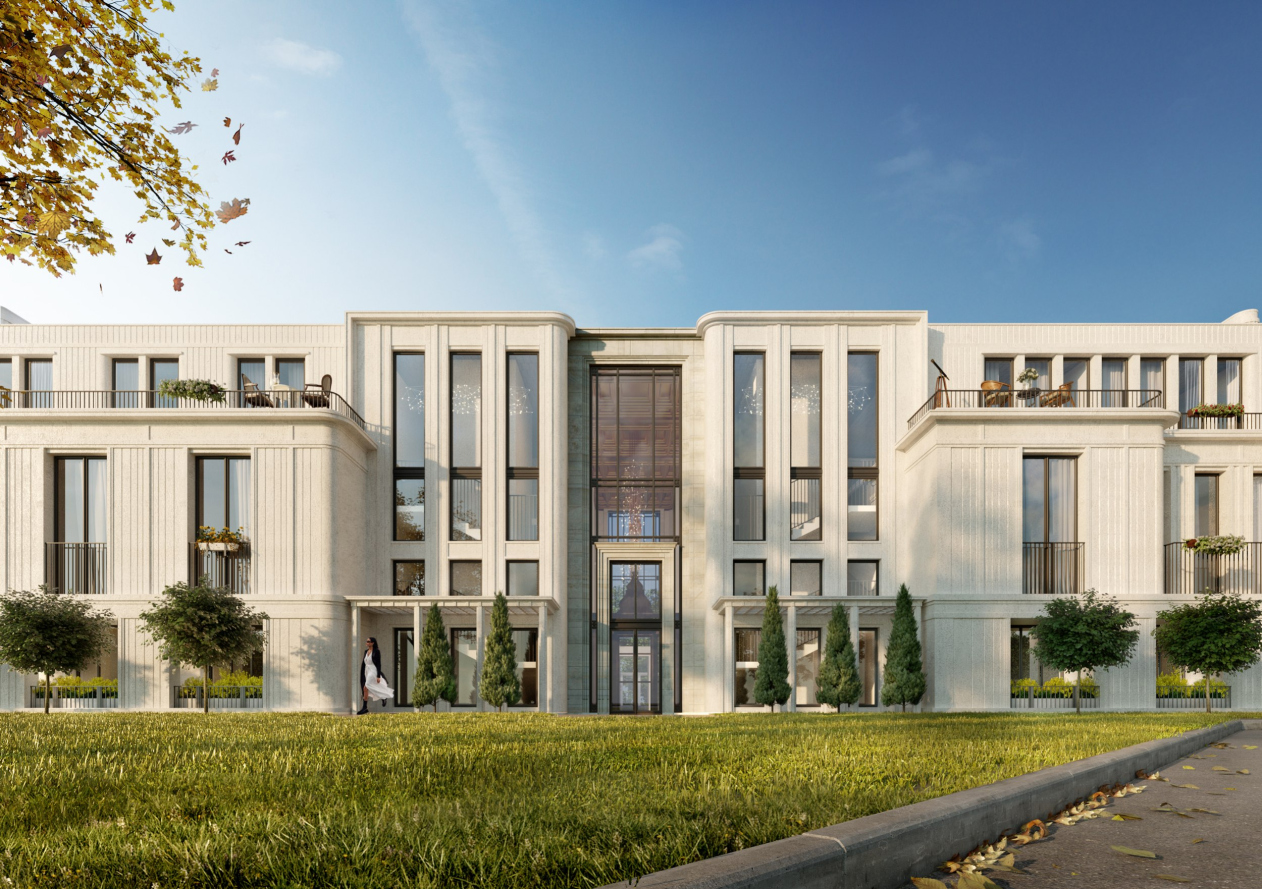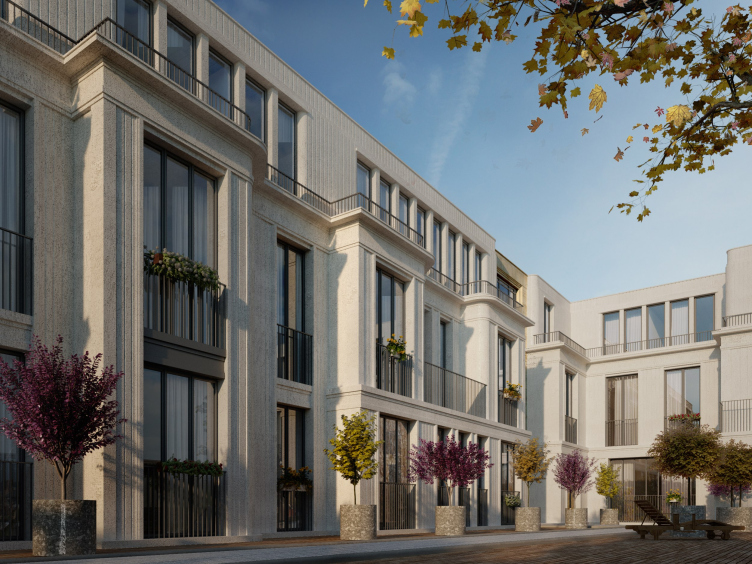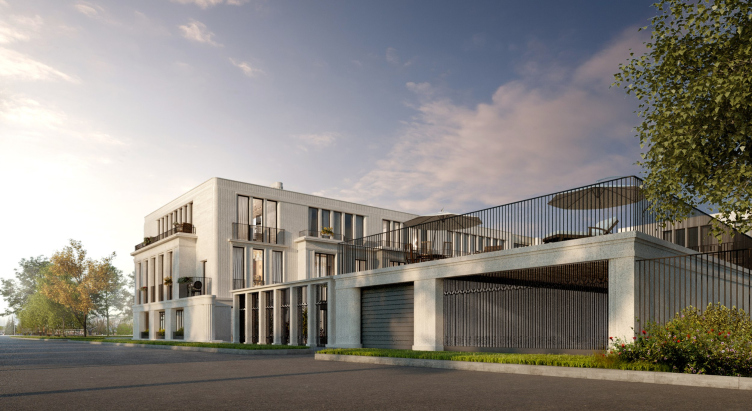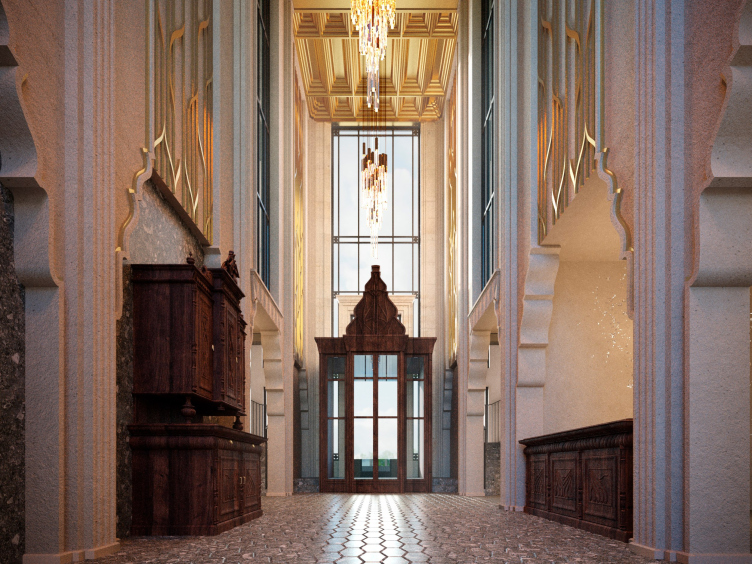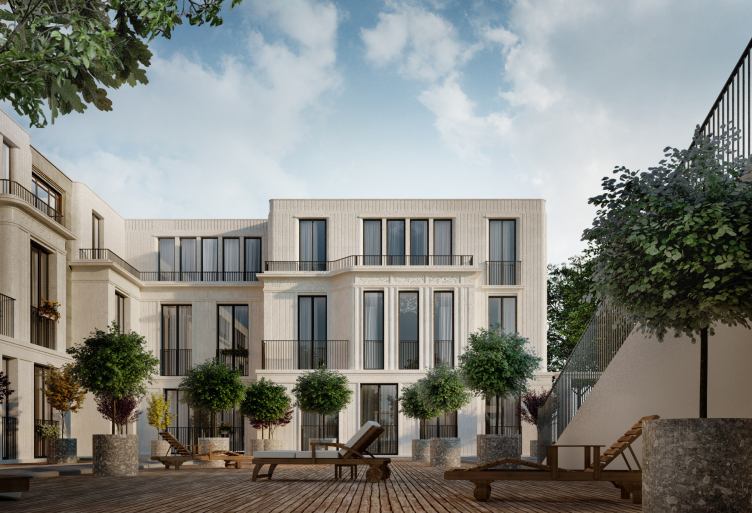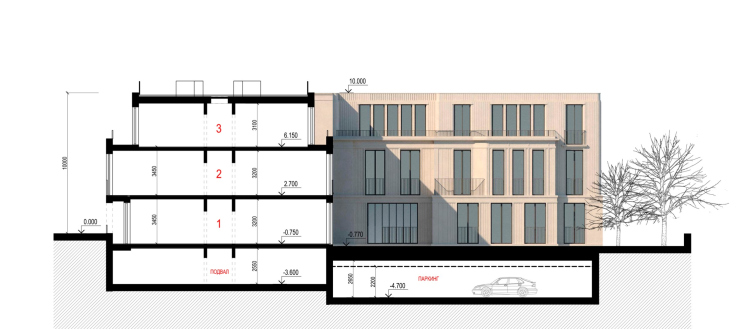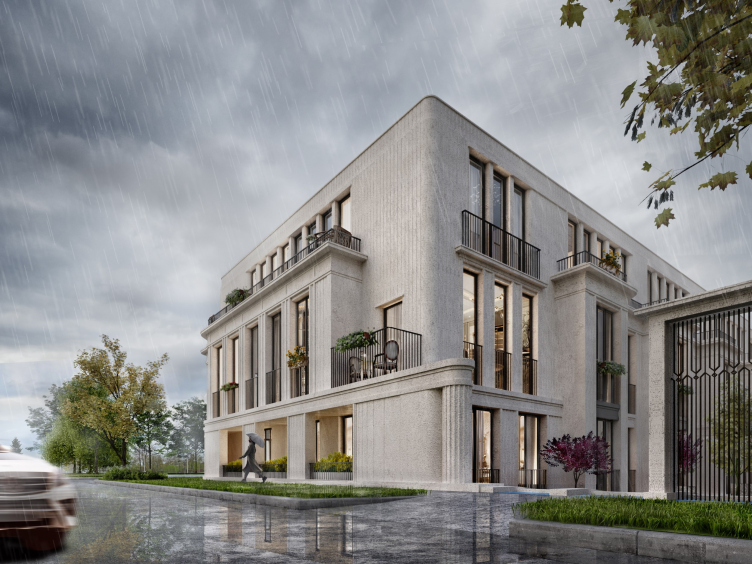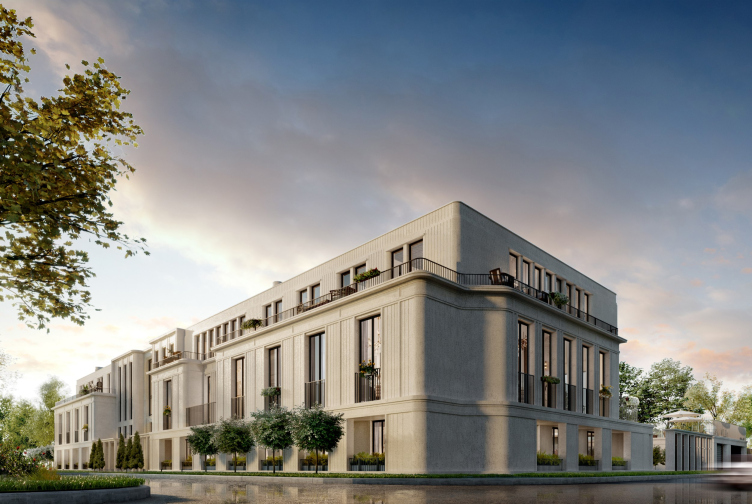This invitation makes perfect sense – in addition, the architect had already worked in Kaluga; his works are well-known for his interest in the style of the 1930s, which Liphart interprets so masterfully and creatively.
The house, proposed for the center of Kaluga, is exactly of this kind. It combines a reserved character of its curves and the respectable stone-like plaster of the facades. On the other hand, stucco was proposed as the finishing element, but this does not matter much in the framework of this concept because if the project were implemented, fiber-concrete could be used just as well. What mattered were the shape preferences.
And the shape here is interesting indeed: without violating the height restrictions, and staying within the limits of three floors, Stepan Liphart was able to propose a solution that was simultaneously monument, rhythmic, and well-organized, chiefly thanks to the proportions, lots of bay windows, colonnades, piers, and vertical flutes on the wall surfaces. At the same time, the house is light, transparent, and flexible: it has large windows, lots of terraces on the upper level, and rounded corners. Such a house would have been appropriate somewhere in Nice before World War II; it has a few things about it that are quite surprising in Kaluga, yet it fits in very nicely with the local context too due to its sybaritic character.
View of the southeast facade from the yard. The housing complex at Akademika Koroleva Street, 3.
Copyright: © Liphart Architects
The project is based on two planning axes of different characters. The volumes, including the residential buildings and the entrance to the car park, surround the courtyard in an asymmetric U; the yard opens on Koroleva Street, and on this side, the main entrance is situated – through the gate that breaks the tall colonnade with a grille. First of all, it is turned in the direction of the Space Museum and its park, and it interestingly “mirrors” the entrance frame of the modernist building across the street – a very “contextual” idea. Second, the solution is very much “Saint Petersburg”, and it slightly resembles the Benoit House on the Kamennoostrovsky Avenue, and many other similar compositions of the early XX century.
Overview from the south. The housing complex at Akademika Koroleva Street, 3.
Copyright: © Liphart Architects
Underneath the yard, there is an underground parking garage; underneath the houses, there are cellars, and there is also a playground with an amphitheater in a remote corner – it is situated beyond the compound’s barrier, and is available to city people.
The second axis is a traverse one. The main residential building, which stretches along Gogol Street, was supposed to have an end-to-end atrium in its north part – on the axis running parallel to Koroleva Street. It led to an art object on the eastern border.
This entrance is not named as the main one, yet it is still more stately because it is “on the city side”. Theoretically, here, alongside Gogol Street, a whole new city street could have formed: the little namesake park on the opposite side of the drive was set off by the facade front, forming the “redline” with a recessed entrance space and pergolas on the sides. On the inside, there are two staircase and elevator halls on either side of the entrance, and a high-ceilinged through passage with glass walls and stone portals that look like marble frames of the antique cities. Symmetric, transparent, and solemn. Obviously, this is the “grand” entrance.
Overview of the entrance group from the northwest side. The housing complex at Akademika Koroleva Street, 3.
Copyright: © Liphart Architects
A while after he worked on the main project, Stepan Liphart proposed a luxurious interior design for the atrium: with golden caissons on the ceiling, carved oak cases, and elements of “flame gothic” bringing up associations with British fireplaces, even though there are no actual fireplaces here.
Visualization of the passage of the interior of the entrance group. The housing complex at Akademika Koroleva Street, 3.
Copyright: © Liphart Architects
Another interesting feature of the project is that staying within the height limit of 10 meters, yet looking not to lose in the scale, ceiling height, and proportions, Stepan Liphart proposed to sink the house into the ground a little bit, which was not much of a problem, considering that it stood on an underground car park and cellars. Both the yard and the first floor are sunken by about 75 centimeters. This makes the yard space even more private and cozier – the effect is further enhanced by wooden flooring that the architect proposed.
Overview of teh yard from the southwest. The housing complex at Akademika Koroleva Street, 3.
Copyright: © Liphart Architects
The apartments of the bottom floors received another bonus – they have recessed balconies marked in front of them, whose floor is also lowered by 75 cm compared to the sidewalk level; they are protected from the city by greenery. The semi-private spaces, sufficiently hidden from the eyes of the passers-by (rather sparse here), and open enough to fresh air, bring up associations with little front gardens, usually placed inside of the yards, and not on the street, or about the galleries of the first floors, usually occupied by local businesses. For the shops, however, there are too few potential customers here, and the surroundings have a lot of “country home” quality about them, so these terraces seem to be the perfect solution. One should note that this is a rare format nuance; at least, this is the first instance of this I’ve seen so far.
A cross section view. The housing complex at Akademika Koroleva Street, 3.
Copyright: © Liphart Architects
The house eventually receives some rather sophisticated plastique; it is reserved, yet active in its interaction with the surrounding space, one part of its interaction being determined by its inner organization: the recessed balconies of the first floor neighbor on the terraces of the second and particularly third ones, as well as on bay windows and pergolas, let alone the “French” windows reaching to the floor with the lattices of their barriers – unexpectedly tall and slender. The house constantly changes the scale of its elements: the first floor is small, especially because of the fact that it is sunk in the ground, the second seems huge, a real “piano nobile”, the third again looks smaller – like an attic – although this is mainly due to the terraces, the ceiling height is almost the same, 3.2 / 3.2 / 3.1 meters. Meanwhile, the image, with the actual equality of floors, corresponds to the classical “triad” of bottom, middle and top.
Fragment of the southwest facade. The housing complex at Akademika Koroleva Street, 3.
Copyright: © Liphart Architects
The sum total of plastique techniques also develops the reservedly classicist approach with a twist of something that I feel like calling “retro-progressivism”, even though the official term for it is “streamline”. Streamline is a design trend of the 1930s. It likes flowing lines and curves, yet not of the kind that you see with Zaha Hadid, but controllable, symmetrical, and repeating. In this instance, it is echoed by the rounded corners of the volumes, their “striped” surface, frames with rounded corners around the entrance, and smooth chamfers of the bay windows. All these lines, made of stucco or “stone”, look as though they were molded by some metallic guides. When they meet in a corner, the two chamfers of the bay windows form something like a pair of smooth “wings” – an unexpected solution for a corner where two ledges collide.
Overview from the west. The housing complex at Akademika Koroleva Street, 3.
Copyright: © Liphart Architects
This house is not exactly classicist- I think that the other contestants proposed even more traditional versions. One thing this house does not have is a cornice, which, combined with a striped texture, produces quite a fresh look. There are also conservative inclusions, however, such as a fluted column standing to the left of the “main” entrance to the yard as an artifact. I wonder what the art object in the yard could have looked like? These two could resonate.
All of this, however, does not make any fundamental difference. The project is designed in a recognizable style, springing from Liphart’s graphic fantasies of the “Jophan’s Children” period. And this seems more than appropriate for this land site: in the close proximity of a modernist masterpiece, the Space Museum, and a neo-Russian “Turkish House”, reminiscent of the buildings of the architect Pokrovsky, surrounded by rustic houses and panel five-story buildings, in a word, in the context of the museum and park tourist periphery, such a house would bring a certain charm. Or maybe it would have become the embryo of a distinct urban environment on a small scale.

